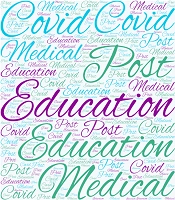Dear Editor,
The coronavirus disease 2019 (COVID-19) pandemic hit everyone off guard, which was not because we had no idea it was coming. We had been warned about the chance of an outbreak by epidemiologists long before. The reason is that none of us were prepared, not even those warning everyone else. Numerous countries went into quarantine; offices and businesses were shut down, and globally the health care system went into an overdrive doing its best to manage patients with limited resources and whatever knowledge of the disease available at the time. With burnt-out healthcare staff, the cogwheel got stock somewhere else that is in medical education.
For most of history, medical education was based on an apprenticeship model; the students would learn based on modeling their mentors and their demonstrations. Roughly speaking, this model was updated only about 100 years ago when learning the fundamental basic sciences was added to deepen medical students’ understanding. The current crisis forces us to rethink this blueprint and take innovative measures. How do we train well-prepared physicians while keeping everyone safe simultaneously?
In Iran, universities first responded by canceling class attendance on campus and pulling those still in externship almost entirely out of the hospitals, followed by a significant reduction of interns present at hospitals in each rotation. This might have been a desperate attempt on social distancing, adhering to protocols, and controlling the spread of the disease and to some extent it helped the following issues; however, it was not without a cost.
With regard to the awareness of the gap created by the level of familiarity, cost, and access to technologies, classes were held online and at the mercy of how each professor considered fit to use the medium (and at whatever hour, given I once had an exam at 11 pm). Some professors embraced the opportunity doing their best to engage students in the virtual classroom; nevertheless, the rest were confused over utilizing technology. Nonetheless, no matter what, every educator agrees that the atmosphere, engagement, and social facilitation created by observing the students’ responses cannot be replaced by any virtual classes (1). I do not think examining the issue of grading based on suboptimal online tests would be of much help. Switching to online platforms tilted the scale unequally in favor of students more experienced and creative with technology at the same time depriving all students of clinical experience, an essential part of learning how to be a physician.
Becoming a well-equipped physician requires more than only textbook knowledge; it is needed to apply the knowledge at the bedside, build rapport with the patient, gain patient trust, observe, and probe the history well enough; accordingly, you can read between the lines; this skill is an art all on its own; learning how to perform examinations and the basic medical procedures even when demonstrated on a moulage take practice on a living patient in real chaotic emergencies to fully master. What is theoretically studied is not always applicable to clinical conditions. Theoretical knowledge is different from clinical expertise.
A noticed thing was that non-COVID-19 patients started to disappear from the clinical setting due to two things. The first one was the fear of virus transmission that made individuals avoid hospitals altogether, in return exacerbating numerous diseases that should have been treated early. The second was the great number of COVID-19 patients that altered the ability and capacity of hospitals to handle other patients in need of care. Although the healthcare system barely hanged on to dear life through each pandemic wave, the true devastation is yet to come. When we look at those lucky enough to still attend clinical rotations, we observe that they missed out on various patients, diseases, and clinical experiences crucial to preparing a well-trained physician to serve the healthcare system in the future. This potentially could put the already overworked healthcare system in a negative feedback loop of inexperienced physicians that replace the burned-out experienced staff, who one day might even be in charge of training the future physicians. Currently, our only options seem to be spreading the limited clinical opportunity equally among the students and creatively constructing real bedside conditions either virtually or in actual classrooms in hopes of establishing the skills they will demand in the future.
Although the above-mentioned issues suggest a bleak future for healthcare education, most studies on the value of digital medical education gave positive feedback from the approach (2-4) and, as proposed by the World Health Organization, have the potential to improve the competencies of health professionals (5). Calling attention to the gaps that need to be filled might be the first step for directing the innovation where it is required the most. Interestingly, studies from developed countries tend to praise virtual medical education; however, developing countries give negative reports on the subject (3). In a study conducted in Iran, the lack of recourses that hindered some students’ access to the virtual material, unfamiliarity with the technology, and the lack of interaction and a suitable platform for clinical training were observed to be the main faced challenges (6).
Medical education plays a unique role. We need well-prepared physicians to combat the crisis and ensure the future of our healthcare system and require them to research and find innovative solutions for this global challenge we are facing. How this generation will learn and pass on the tradition will undoubtedly impact everyone in the society and possibly revolutionize how we approach medical education in the years to come.
